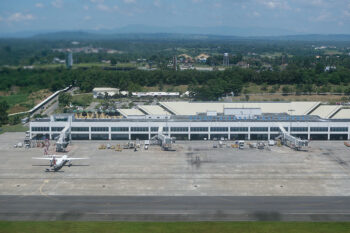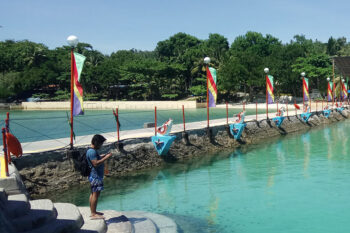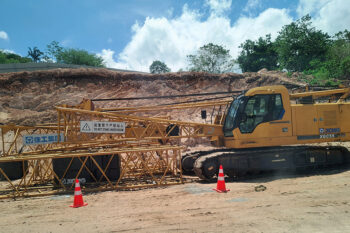QUEZON CITY (MindaNews/07 Nov) — Building on consensus points is probably the best way to describe the process that led to the document that we now call the Framework Agreement on the Bangsamoro (FAB). The document signed last 15 October by the Government (GPH) and the Moro Islamic Liberation Front (MILF) outlines the roadmap that will lead to the creation of the autonomous Bangsamoro government.
Visually, it was a movement from plain text to boldface. As soon as the two panels agreed on the substance and the language, the secretariat member handling the laptop selected the text and clicked the boldface box on the menu. That person was either MILF’s Muhajirin Lanang or GPH’s Iona Jalijali.
When the Malaysian sun began to set on Saturday of 6 October, only the section on “normalization” and “powersharing” were pockmarked with plain and bold print. Shuttling of drafts on the unsettled provisions had been going on the whole day. There was a lot of running here and there along the huge hallways of the hotel where the meetings took place.
Soon it was only a matter of finding the acceptable preposition. Shall it be ‘in’, ‘of’ or ’for’? We wondered: will a single word break the whole agreement? It did not. Are we going to extend for another day? No need.
When we convened for the plenary in the evening, the agreed texts were put on the table and converted into boldface. Closing speeches from the Malaysian facilitator, Tengku Dato’ Ab Ghafar Tengku Mohamed, and the two chairs Mohager Iqbal and Marvic Leonen followed.
People stood up and clasped hands with each other. Everyone was stunned that the document had been completed!
The negotiation process
Much earlier, in February 2011, the MILF handed over to the GPH panel its 40-page Draft Comprehensive Compact. The GPH panel accepted this as a reference, and not necessarily as the document on the negotiating table.
In turn, the GPH handed a much shorter “3-for-1” proposal in August 2011. Iqbal described the gap between the documents as that between “heaven and earth.” A stalemate ensued.
The deadlock was unhinged when the two parties moved to a negotiation strategy of consensus-building. First we worked on identifying and crafting into a text the shared points. All contentious issues were set aside.
“Let’s park that” or “Let’s sleep on it” became the mantra when no one wanted to concede, especially after sitting out explosive or emotional speeches. In several such “hot” moments, the facilitator Tengku Ghafar would unceremoniously cut the exchange with a call for a break.
Informal or executive sessions where only two or three panel members plus 1 secretariat member discussed closed-door also allowed the two parties to identify bottom-lines and explain their positions more clearly. These were called the ‘2+2’ or ‘3+1’ meetings. At the tailend, when formulations were being exchanged, informal sessions were reduced to chair-to-chair. All these sessions were attended by the facilitator.
From decision points to framework
The first fruit from the combined methods of formal and informal talks was the April 2012 Decision Points on Principles. The first of the Decision Points acknowledged a core value for the MILF. It stated simply that the “Parties recognize Bangsamoro identity and the legitimate grievances and claims of the Bangsamoro people.”
The rest of the document stated “that the status quo was unacceptable” and that the two parties shall work for the creation a new political entity (NPE) to replace the Autonomous Region in Muslim Mindanao (ARMM) which shall have a ministerial form of government. There shall be a transition process including third-party monitoring and power and wealth-sharing between the NPE and the central government, with reserved powers like defense, foreign affairs and fiscal and monetary policy reserved at the national level.
Interestingly, the document did not invite hostility after it was made public. Except for a few negative commentaries, the public was keeping its mind open. Besides, other national events like the ongoing impeachment trial of then Supreme Court chief justice Renato Corona and high-profile crimes captured the public’s attention. And so we moved on.
Eventually the process and format was agreed: finish a framework document with the annexes to follow. That it happened this way flowed from the negotiation dynamics.
We gave them a draft framework agreement; they gave us another. Knowing how important it was for the MILF to use their own words, we agreed to work on theirs. In August, the Technical Working Groups for power-sharing and wealth-sharing were convened to work on the details. This allowed the two panels to concentrate on the Transition, Territory and Normalization texts.
Metaphors
Throughout the process, we played around with metaphors. The first one advanced by the MILF was ‘the driver’s seat’. They had wanted a seven-year transition period where the MILF was on the driver’s seat. Seven years is too long, we argued. The transition would cross over to the term of the next president without guarantee of full support.
Secondly, we said, we‘d need to be more inclusive. The MILF smartly replied: this bus will be big; there will be many passengers. We scratched out head for alternative metaphors. How about a dragon boat where many paddlers steer concertedly?
Before the bus or the boat caught on, we settled on the road map that one now finds in the FAB. The transition period has been shortened significantly in order the put in place the Bangsamoro government by 2016. The Transition Commission and other mechanisms shall be inclusive and co-exist with the ARMM officials elected in 2013. The short period between the plebiscite for the new law and the 2016 election will allow the MILF a period of governance to usher in the new political entity.
At the July general assembly of the MILF in Camp Darapanan in Sultan Kudarat, Maguindanao which we all attended, Tengku Ghafar came up with the next powerful metaphor to describe the stage of the talks. Tengku declared to this effect: The two panels are now on the same page, soon they will be on the same paragraph, reading the same lines.
As I listened to him, I nodded my ahead in agreement. But inside I worried: afterwards, we’ll need to read behind the lines, dot our Is and cross our Ts. Indeed, it took us another three months to finish the FAB.
Peace talks as a wedding
In our longest meeting from October 2-7, Tengku Gaafar again waxed allegorical: “This is preparation for a wedding. The two families are still negotiating the dowry.” When things got tough on October 7, “The couple are having cold feet,” he said.
Interestingly, lawyer Raissa Jajurie, MILF consultant and technical working group member who also alternated as panel secretariat, was actually getting married on October 7. She was the lone woman who had accompanied the all-male MILF team. Only recently did another woman, Jukra Abdulmalik, come along.
Raissa, a Tausug, was set to marry, Maguindanaoan Guiamel Alim, a Bangsamoro civil society stalwart. When the meeting was extended, many of those in the room who were invited were no longer able to attend her wedding.
Coincidentally, when we were whisked to Malacanang from the airport on October 9 to meet with the President, PNOY in Filipino likewise slipped into the wedding metaphor.
After the signing ceremony, PNOY again reportedly mused: this must be how it feels after getting married. He was referring to the enormous task of making the marriage work after the euphoria of the wedding day.
Building a house
What is the Framework Agreement? How can we explain it to the public in simple terms?
I asked Datu Antonio Kinoc, MILF panel member from the B’laan tribe how he would describe the FAB. Kinoc said it was like a skeleton whose meat will still be fleshed out. GPH panel member Senen Bacani thought of a house with frames, roofs and basic parts, but with the interior unfinished and the annexes still to be built.
We agreed that the image of building a house resonates to an ordinary citizen.
An agreement as text
The care that both sides in the negotiation took in crafting the words springs from the realization that after all the speeches and the rhetoric, everything will have to be put down in written words. The same words will mean different things to different people. Indeed, this has happened.
To illustrate, an esteemed colleague at the University of the Philippines, law professor Raul Pangalangan mistook the provision on the authority of the Bangsamo to receive “block grants and subsidies from the Central Government” as the power to block grants. Naturally, he wondered why they would even refuse manna.
Indeed, even a grammatically upright sentence can be misread by transforming an adjective into a verb. “Block grants” in the sentence refers to lump sum funds for special development programs or projects. It is a technical term used in financing and economics. It is not used here as a verb meaning to refuse or prevent.
Another word that has elicited concern is asymmetrical as used in : ”The relationship of the Central Government with the Bangsamoro Government shall be asymmetric.”
Asymmetry is not a legal term. In layperson’s language, it connotes unevenness. In our discipline in political science, there is “asymmetry” when a territorial unit within a political system that enjoys a distinct or special status because of its peculiarities.
On the other hand, “symmetry” is what characterizes the different states that make up the United States of America. The states enjoy the same status among themselves vis-à-vis the central government.
‘Asymmetrical’ is a term that has been applied with reference to constituent units in both unitary states and federal systems. Aceh in the unitary Republic of Indonesia is a good example of a province with an asymmetrical relationship with the Indonesian government.
Without looking any farther, another good example is the regional autonomy contemplated in Article X of the 1987 Philippine Constitution that states, among others, that there shall be an autonomous region in Muslim Mindanao and the Cordillera. These autonomous regions are different from the regular local governments in the provinces, cities and municipalities. Thus they are asymmetrical.
For this reason, the GPH saw no serious constitutional issue in accepting the description. It is a relationship that enhances the status of one part without diminishing the standing or sovereignty of the central over its parts. In concrete terms, the president shall continue to have supervisory powers over the Bangsamoro and shall likewise have jurisdiction over major powers such as defense and foreign affairs, among others.
Women at the table
Many more questions will come, and many more twists and metaphors will follow. Let me end with a brief recognition of the women at the table.
Sr. Mary John Mananzan had once mused about the paintings of the Last Supper that depicted a long table with 12 men spread out left and right of Jesus. She asked the provocative question: so who cooked the food?

Yes there were a few good women who were all part of the making of the FAB. And they were not just hidden in the kitchen, they were seated on the tables, planning the menu, thinking of new recipes. It’s just that the photos would always be cropped to include only the head chefs.
Who were these able and fine women? Joining me at the GPH panel is Presidential Assistant for Muslim Affairs Yasmin Busran-Lao. Our secretariat head is Iona Jalijali Maguindanaoan Johaira Wahab and Armi Bayot from the Solicitor-General’s Office make up the legal flank, with Amirah Pendatun as one of the research assistants.
Two of three members of the government’s Technical Working Group on Wealthsharing are women: NEDA regional director Lourdes Lim and Department of Finance executive director Trinidad Rodriguez. Our support staff is overwhelmingly female.
The MILF has the two women mentioned above, Raisa and Jukra, on their team. Conciliation Resources’ Emma Leslie is the sole woman-mainstay in the International Contact Group. Recently the Turkish Embassy was represented by a female diplomat. And the Malaysian facilitator’s secretariat is headed by Madame Che Kasna.
To be sure, it was the women in the room who secured the “meaningful political participation and protection from all forms of violence” clause now found in the FAB. They owed it to themselves and their fellow women of this entity-in-the-making called the Bangsamoro. (MindaViews is the opinion section of MindaNews. PeaceTalk is open to anyone who wishes to share his/her thoughts on the peace process. Miriam Coronel-Ferrer is a Professor at the Department of Political Science in the University of the Philippines and a member of the government peace panel negotiating with the MILF)







